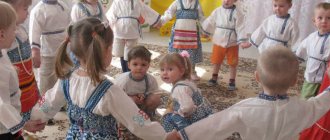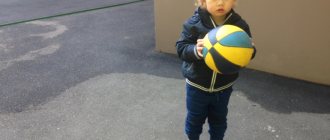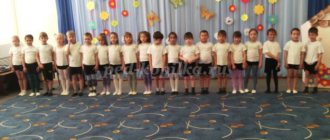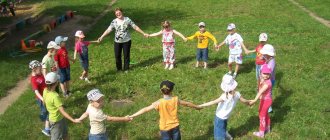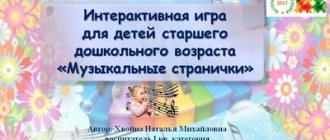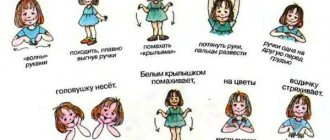Olga Ivanova
Card index of fun games for older children
Card index of games - fun for older children
Prepared by: teacher Ivanova O.V.
Fun games No. 1
«Potato»
Goal: To encourage emotional responsiveness, develop communication skills with adults and peers.
Move: All players stand in a circle and pass the ball to each other, hitting it. If someone does not hit the ball, he squats in the center of the circle and the game continues. Any player can help out the “offender” if he wishes. To do this, when hitting the ball, he tries to hit those sitting in (the one who was touched by the ball)
takes part in the game again.
Those sitting inside the circle try to catch the ball flying towards them.
If someone succeeds, then all those “punished” return to the game, and the player who threw the ball takes their place. Fun games No. 2
"Paints"
Goal: To encourage emotional responsiveness, develop communication skills with adults and peers.
Move: One of the players is the “buyer”, the other is the “seller”, all the rest are the “paints”. Each “paint” wished for its own color and told it to the “seller”. “Paints and the seller” sit on the bench and the buyer immediately comes: “Knock-knock!” “Who’s there?” asks the seller. "I, the buyer." “Why did you come?” “For paint”, “For which one?” A specific paint color is called; if it is not there, the “seller” replies: “There is no such thing. Jump along the path on one leg!” The “buyer” makes a circle on one leg and returns for more paint. If there is paint, the “seller” says: “There is one. Pay... rubles." The “buyer” “pays” - by clapping his palm the required number of times, the “paint” jumps up and runs away. The “buyer” tries to catch the paint ; if it succeeds, the “paint” becomes the “buyer”.
Fun games No. 3
"The quieter you go, the further you'll get "
Goal: To encourage emotional responsiveness, develop communication skills with adults and peers.
Progress: At a distance of 30 meters from each other, two lines are drawn - “ start ” and “finish”. The players stand at , the driver stands with his back to them at the finish line. He says the phrase: “The slower you go, the further you will go. One two Three!". During this time, players try to get as close to the finish line as possible. Having finished speaking, the “driver” quickly turns around and examines the participants in the game, who must freeze. The one who moves goes beyond the starting . the start line first wins . He becomes the driver.
Fun games No. 4
"Dodgeball"
Goal: To encourage emotional responsiveness, develop communication skills with adults and peers.
Move: All players, except two, stood in a line in the center of the court. They, throwing the ball to each other, had to knock out all the players. The one who was touched by the flying ball comes out! from the game. When all players were eliminated, the game started over.
Fun games No. 5
"Ring"
Goal: To encourage emotional responsiveness, develop communication skills with adults and peers.
Procedure: Play while sitting on a bench. Everyone folds their palms in a boat, and the leader, who has a small object in his palms (a ring, a pebble), runs his hands between the palms of each player, quietly puts a ring in someone. Stepping aside, he says: “Ring, ring, go out onto the porch! "The player with the "ring" must quickly stand up, and the other participants must hold him. If it was successful, he became the leader.
Fun games No. 6
"Magic Palms"
Task: exercise to develop a sense of one’s own movement.
Progress of the game:
“Water, water,
Wash my face (children perform washing movements)
To make the eyes sparkle (children show round eyes)
To make the cheeks red (children hold their cheeks)
So that the mouth laughs (children smile)
And the tooth bit him.” (children click their teeth)
Fun games No. 9
“Our Masha is small.”
Purpose: exercise to develop a sense of self-movement
“Fun toys as the basis of children’s play” material (junior group) on the topic
“Toys are fun as the basis of children’s play”
Fun toys can evoke an emotional response in a child, stimulate his development, intensify play, and promote the musical development of children. Thus, the problem of using toys to solve the problems of development of preschool children is currently relevant.
Purpose of the work: to expand the understanding of the richness of the world of toys and fun; show how toys influence the development of children of different age groups; promote the development of the emotional sphere of motor activity, expand the cognitive abilities of children.
The objectives of fun toys: To interest and captivate children with the beauty and unusualness of fun toys. Arouse interest in the toys of parents and grandparents. Expand knowledge about the history of Russian toys. To instill in children, through family and friends, kindness, responsiveness, love of traditions, and respect for toys.
Types of fun toys: “twitchers”; balls with elastic bands; gymnasts spinning on horizontal bars; jumping birds, frogs, butting goats, etc.; Folk toys made of wood and papier-mâché with ingenious devices that produce an amusing effect are widely known (pecking birds, carousels, moving wooden toys; amusement toys also include sets of tricks and surprise toys.
Their meaning: “fun toys”, as defined by E. A. Flerina, are used to entertain children; arouses curiosity, joy and positive emotions in children; maintain a cheerful mood, develop a sense of humor and curiosity; encourage children to study their structure, principle of operation, and also create a zone of shared experiences with adults. especially needed in children's groups of different ages, where older children can please the younger ones with a fun joint game with a funny toy; allow the teacher to establish contact with children, relieve tension, distract children from unwanted behavior, and create a desire to participate in joint play.
Basic requirements for the manufacture of fun toys
1) creation of a wide range for each age group of children;
2) a fun toy must be durable.
The influence of toys and fun on children under one year old: The child’s objective actions are related to his psychophysical development. As soon as the child begins to sit, he loves to manipulate the toy, trying, in imitation of an adult, to knock on a funny apple or pegs with a hammer. Children from five to nine months are shown toys that stimulate crawling, including large, bright tumblers. And these are one of the first toys that we classify directly as fun toys. A child enjoys playing with a tumbler doll at a very early age. The baby happily examines the tumbler, rocks it, pushes it, watches its movements and listens to sounds while playing. As soon as he drops this toy, it immediately takes a standing position on its own.
The tumbler is considered a traditional toy for children. It combines a rattle and a stabilizing device, attracts with its bright color, shape, comfortable and safe for the baby. According to the figurative solution, tumblers are, first of all, dolls, bears, dogs, birds, both of a design familiar to many generations and of an unusual design. There are also construction tumblers with parts of varying degrees of hardness and different sizes.
The influence of toys - fun on children from 1 to 2 years old.
After the first year of life, the child is also shown twitch toys, medium-sized or large-sized tops with a sound effect, and squeaker toys (when touched, a sound or melody is heard). For fun and development, there are educational games for children from 1 to 2 years old, and toy books have been invented (with a sounding device, for playing in water, etc.). Toy books with a sounding device are made of fabric, thick cardboard.
The influence of toys - fun on children 2-3 years old.
Fun toys for children under 3 years of age are intended to be played with an adult, under the supervision of an adult. But a one and a half year old child can already launch a small top. The toy develops fine motor skills well. A thin, comfortable handle, light weight, and the child enjoys learning to correctly calculate the strength and precision of the movements of the fingers and hand. A funny-sounding toy - a metal organ with a surprise. The barrel organ makes a pleasant melodic sound. Playing with a barrel organ promotes the aesthetic development of a child and improves the emotional background. First, the child is introduced to the inhabitant of the barrel organ, music is played, and then a surprise moment can be arranged.
The influence of toys - fun on children 3-4 years old.
For children 3-4 years old, figurines of animals and birds with a winding mechanism are especially interesting. Wind-up toys can diversify the actions of human and animal figures. The figures can be united by a common plot and represent toys that imitate actions (pecking, jumping, dancing, playing music) with various effects (musical, noise, color, light, etc.). Children independently play with pleasure with funny ducklings, pecking birds, and soft voiced animals that imitate the action. Bright, colorful bunnies, squirrels, bears, dogs, and cockerels immediately attract the attention of children. They find and recognize in these “fun” images of familiar animals and birds, and the game develops - children build houses for the animals, give them rides in cars, and invite them over for lunch.
The influence of toys - fun on children 4-5 years old.
At the age of 4-5 years, the nature of games for children changes, so folk toys made of wood (“Blacksmiths”, “Chickens on a Circle”, “Magpie and Squirrel”, “Gymnast Bear”, etc.) appear among the fun toys for them. funny figures with mechanisms (moving on an inclined board “Ducklings”, “Bull”, “Vanka-Vstanka”, etc.), bibabo dolls, voiced tops and tumblers, turntables.
The influence of toys - fun on children 5-6 years old.
Children 5-6 years old are interested in mechanical and electrified toys, as well as hydraulic, pneumatic, and articulated ones. The electrified railway is offered as a fun toy to be shown to children aged 5-7 years. Fun toys for children 6 years old are small tops made of different materials, homemade tops, figurines of animals and birds with funny movements, with music, singing or onomatopoeia, voiced (for playing “concerts”, etc.), funny caricatured animal figurines (with magnet).
Methods of practicing with toys and fun.
It is recommended to play fun games with preschool children every day in the morning or evening, when the teacher and children have a “free minute.” The duration of the fun games cannot be determined exactly. You need to play with children until they really have fun, rejoice and have fun. This time ranges from 1 to 5 minutes. It is not advisable to increase the duration of fun games, because overexcitation and overwork have a negative impact on children's health.
When conducting fun games with children, a mandatory condition is to provide them with free use of the toy with which the children acted under the guidance of an adult. It is advisable to accompany all the teacher’s actions with words: • first with direct instructions, • then with verbal instructions, of course, while focusing on the child’s experience. The content of fun games (shows) should be more “intricate” than children’s actions in independent play, but taken from real reality, close to the child. What is required from the baby? Carefully monitor the teacher’s actions and listen to his explanations. And this is only possible if he is interested. When playing entertainment with children, you should keep them all in sight, guide the children’s activities, immediately respond to emerging conflicts, and suggest the next course of action. The special task of the teacher is to arouse a keen interest in the game in children, to please them, to make them laugh, and to create a good mood.
Results of using fun games in educational activities:
• create a good, joyful mood in children;
• contribute to the establishment of positive relationships between the teacher and children;
• develop children's speech;
• develop fine motor skills of the hands;
• introduce the child to fun toys;
• enrich children's emotional experiences;
• contribute to the disclosure of the creative potential of the teacher.
Thus, fun toys (swinging bull, pecking chickens, blacksmiths, sawy bears) are intended to amuse and entertain the child. They evoke curiosity, joy, and positive emotions in children. Fun toys maintain a cheerful mood, develop a sense of humor and curiosity. They encourage children to study their structure, principle of operation, and also create a zone of shared experiences with adults. Fun toys help the teacher organize collective entertainment. This type includes surprise toys with a variety of movements, sound, light and other effects. The toys are simple, dynamic, with gentle humor. They show the wisdom, ingenuity, ingenuity of folk craftsmen, their love for children, and their desire to amuse them.
Progress of the game:
Our Masha is small, (children bend down to the floor and show little Masha)
She is wearing a scarlet fur coat (children show the fur coat)
Beaver edge (children spread their hands and show the edge)
Masha black-browed (children point to eyebrows)
Fun games No. 10
“Cucumber, cucumber.”
Purpose: exercise to develop a sense of self-movement
Progress of the game: At one end of the playground there is a teacher (trap, at the other there are children. They approach the trap by jumping on two legs. The teacher says:
Cucumber, cucumber,
Don't go to that end
There's a mouse living there
He'll bite your tail off.
At the last words, the children run away, and the teacher catches up with them.
Fun games No. 11
Purpose: exercise to develop a sense of self-movement
Games and fun in kindergarten for children 3-5 years old
Games and fun for children of primary preschool age, preschool educational institution
Author: Dvoretskaya Tatyana Nikolaevna GBOU School No. 1499 Preschool No. 7 Educator Description: Games are intended for children of primary preschool age, can be useful material for teachers of preschool organizations and parents. Purpose of the work: Author's games for children are aimed at developing the socialization of children, arousing interest and desire to play joint games
Goal: to develop in preschool children the interest and need to play with peers Objectives: 1. to arouse interest in group games in preschool children 2. to form in children a positive attitude and desire to play joint games 3. to cultivate a friendly attitude when playing with peers 4. to develop the cognitive and speech activity of children through play. Preface In modern pedagogical theory, play is considered as the leading activity of a preschool child.
The leading position of the game is determined not by the amount of time that the child devotes to it, but by the fact that it satisfies his basic needs. In the depths of the game, other types of activities arise and develop. Play contributes to mental development to the greatest extent. Dear teachers, I present to your attention my original games for children. I hope the material will be useful and in demand in your work. Game No. 1: “Top-top-top” for children 3-5 years old
This game can be played with children of primary preschool age, both in a group and on the street.
Rules of the game: - Children stand next to the teacher and form a small circle. — The words for the game are pronounced in chorus, rhythmically, with the addition of movements according to the meaning of the text (when learning the game, the teacher will need to show you)
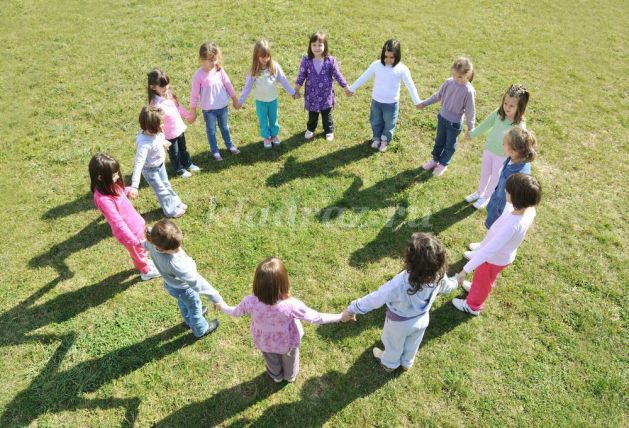
We will make a wider circle
(form a large circle without holding hands)
We will smile at a friend nearby
(turn and smile)
We will hold hands tightly.
(Hold hands)
Step by step we will go, stretch our legs.
Top - top - top! The guys are coming Top - Top - Top! They are going somewhere. (rhythmic steps are taken to the right)
Stop at the gate.
(stopped and stood still)
So there will be a turn.
(turn to the left)
The children turned around together!
You need to keep moving. Step by step we will go, stretch our legs. Top - top - top! The guys are coming Top - Top - Top! They are going somewhere. (rhythmic steps are taken to the left)
Past the river and lakes.
Past the forest, past the mountains. Everyone is walking, their feet are moving. Stop - stop - stop. End of the road. (stopped and stood still)
We have arrived!
Meet us. (turn your face in a circle, stretch 2 arms forward)
And clap 5 times.
(Clap your hands)
Game No. 2: “Snake” for children 3-5 years old
The game is played outside while walking.
Attributes for the game: - A snake drawn with yellow chalk (paint) on the asphalt and 5-6 multi-colored circles (balls) Rules of the game: - Children line up one after another - They say in chorus the call for the game Call for the game: The snake played with balls This is how it played that I'm tired. The poor thing lay down in the shade and was too lazy to crawl any further.
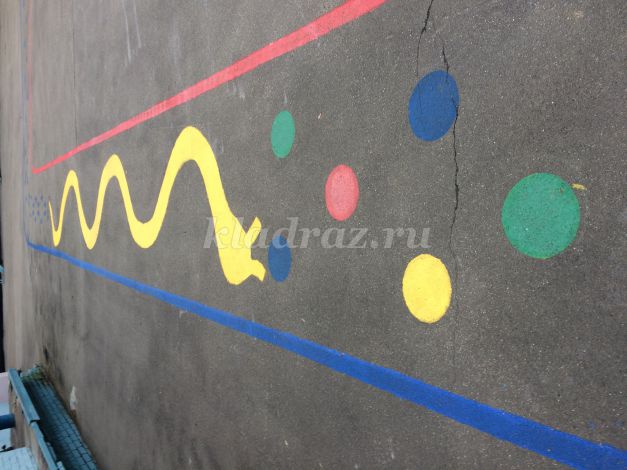
Don’t be timid, my friend.
You run forward quickly. Hide your hands behind your back. Jump on the ball with your feet. (jumping on 2 legs)
One!
Two! Three! Four! Five! We know how to win. Hurray for the champions! The game continues. (Children who have run all the way return to the end of the snake’s tail and, if desired, go through it again)
The game can continue until the children’s interest remains.
Recommendations: The second player starts moving only after the first player reaches the middle of the snake.
Game No. 3: “Cats and Mouse” for children 3-5 years old
This game can be played with children of primary preschool age, both in a group and on the street.
Attribute for the game: - Cat mask Characters: Cat - child Mice - children

Here they are running along the grass Zipper – Zipper – Zipper
(running into the loose grass)
They jumped over the ditch
(jumping on 2 legs)
Jump – Jump – Jump Suddenly a terrible sound was heard
(The teacher knocks on the chair with a stick, on which the cat sits)
And the heart KNOCK - KNOCK - KNOCK The cat hid in the bushes And opened its toothy mouth.
The mice will be in trouble for you. Run away in all directions... (The cat begins to catch the mice, trying to hit them on the shoulder. The mice run away)
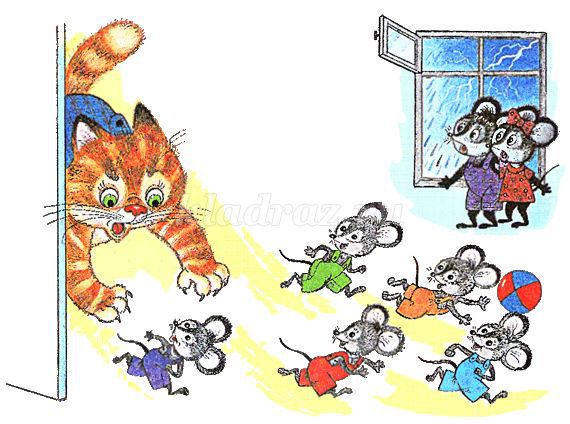
Parting words from the author:
There are a lot of games, entertainment and activities in our world. You should never be bored in the company of friends!
We recommend watching:
Water games for the second younger group. Card index Fun game “Roosters” for the younger group Nursery rhyme “Chicks” for games with children of the younger group Musical games for the younger group of kindergarten
Similar articles:
Coloring pages for children “Pets”
What are educational games for preschoolers
Games to develop attention for children 3-4 years old in kindergarten in a group
Didactic games in the younger group. Card index
Playing with sand in the younger group
Card index of intellectual games in the senior group
MBDOU kindergarten No. 2 in Sychevka.
Card index of intellectual games
in the senior group
Conducted by: Birimzhanova.E V.
Game "Camera".
Target
: develop associative thinking, voluntary attention, memory, speech.
Game material and visual aids
: lotto cards or any other pictures.
Description
: Show the child the card for 5 seconds. Then remove it and ask them to remember what was depicted on it. If the child finds it difficult to answer, ask him a leading question: how much, what color, etc.
Game "Find the differences".
Target:
develop the ability to compare memorized objects, find similarities and differences in them.
Game material and visual aids:
story cards.
Description:
Show the child the card for 2-3 minutes. Then offer him a second card, on which some objects or actions are missing or replaced with others. The child must determine what has changed.
Game "Magpie-white-sided".
Target:
develop concentration and memory.
Game material and visual aids
: 5-6 small items (toys).
Description:
arrange objects (toys) on the table. Invite the child to look carefully at the table, remember what objects are on it, and then ask the child to turn away. Remove or replace one or more items. The child must determine what the magpie stole and what it replaced.
Game "Sleuths".
Target
: develop associative thinking, memory.
Description:
it is necessary to choose one child who will play the role of a “robber”, the rest - “detectives”. Tell some story with the children, from which it follows that the “robber” must now hide from the “detectives” and for this he needs to disguise himself. During the story, the “detectives” carefully examine the “robber,” who then goes off to disguise himself, and upon returning to the room they must find changes in his appearance.
Game "Describe the object."
Target
: teach to remember the signs and properties of an object.
Game material and visual aids
: objects familiar to the child (person, car, food, etc.).
Description:
Children, under the guidance of a teacher, choose a familiar object. The teacher suggests remembering as many distinctive features and properties of this object as possible and naming one feature at a time. The loser is the one who cannot remember anything about the item when it is his turn.
Game “Repeat the ornament”.
Target
: promote the development of concentration and memory.
Game material and visual aids
: beads, buttons, counting sticks (12 pieces each).
Description:
The teacher gives the child half of the playing material, takes the remaining half for himself, lays out an arbitrary composition of beads, then shows it to the child for 1-2 seconds. He must arrange exactly the same composition from his beads from memory. Then you can switch roles. To create the following compositions, you can add counting sticks and buttons to the beads.
Game “Remember - Draw”.
Goals:
teach conscious perception; develop concentration of attention on a memorized object.
Game material and visual aids
: a piece of paper, pencils, cardboard with images of objects.
Description
: stick six pictures on cardboard in two rows: three on top, three on bottom. The pictures should show the simplest objects: an apple, a scarf, a flag, a button, a needle, a Christmas tree, a birch leaf. Show your child the top row for one minute. The child must sketch what he saw and remembered. Then show the same bottom row of pictures and again ask the child to sketch everything that he remembers. Open all the pictures at the same time and compare how well the child’s drawings match the image.
Game “What is she like?”
Target:
promote the development of visual and auditory memory.
Description:
name an object and invite the child to imagine what this object looks like, what shape, color it is, what sounds it can make, etc. Then ask him to describe everything that he imagined. For example: an egg is oval, white or brown, with spots, raw or boiled, white and yellow inside. Then you can not only talk about the characteristics of the object, but also sketch it.
Game "Illogical Associations".
Target
: develop associative thinking.
Game material and visual aids:
cards with a picture of an object.
Description:
It is necessary to tell the child several words related to each other. For example: plate, soap, flower, street. It is better if the child has cards with images of these objects in front of him. Try with your child to find associations that would connect these words. Find a suitable picture for each association. Give space to the child’s imagination, do not limit them to logical associations. The result should be a short story.
Games for developing attention
Game "Who Lives Where".
Target:
develop visual attention and memory.
Game material and visual aids:
drawings with images of families of different animals and their houses, with drawn lines connecting the animals with their houses, which are given in a chaotic order.
Description:
you need to determine where whose house is without drawing a pencil along the lines.
Game "Clap Your Hands".
Goals
: develop stability and switching of attention, cognitive activity of the child; expand your horizons.
Description:
The teacher calls the child different words; if he hears a word that means, for example, an animal, he must clap his hands. Another time, suggest that the child stand up every time he hears a word for a plant. Then combine the first and second task, that is, the child claps his hands when he hears words denoting animals, and stands up when pronouncing words denoting plants. It's good to play these games with several children.
Game "Cross out all the letters K."
Target:
develop stability, distribution and switching of attention.
Game material and visual aids:
small text (from a newspaper or magazine), pen.
Description:
Invite the child to carefully look at the letters in the text and cross out all the letters “k”. Record the time and number of errors. The task can be made more difficult by asking the child to cross out all the letters “w” and underline all the letters “u”.
Game "Change appearance".
Target:
develop observation skills.
Description
: several people play, everyone stands in one line, the leader names one child and invites him to remember the appearance of each participant in the game. This will take 1-2 minutes. Then the child turns away, the remaining participants in the game make minor changes to their costumes or hairstyles. Turning to the players, the driver must name the changes that he was able to notice.
Game "True or False".
Target:
develop attention and memory.
Description
: the teacher pronounces different phrases - true and false. If the phrase is correct, the children clap, if not, then they stomp. For example:
In winter, daisies always bloom. (Children stomp.)
Ice is frozen water. (Children clap.)
Hares have red fur. (Children stomp.)
There is no need to wash your hands before eating. (Children stomp.)
It always snows in winter. (Children clap and stomp.)
Game "Little Beetle".
Target:
develop attention and spatial thinking.
Game material and visual aids
: playing field, lined with 16 cells; buttons.
Description
: the teacher invites the child to help the “beetle” (button) get to the other end of the field, while warning that the “beetle” crawls only in zigzags. The teacher marks a short segment of the “bug’s” path: “One cell forward, two to the right, one to the left.” The child must listen carefully, remember and follow this path with a “bug” across the playing field. When the child learns to remember all the moves of the beetle, you can move on to a more complex task by asking the child to make the moves mentally and place the beetle on the desired square.
Game “Follow the pattern”.
Target:
develop concentration.
Game material and visual aids:
checkered sheet with a pattern of squares, circles, triangles.
Description
: The child continues the sample pattern (circle, square, triangle, dot, etc.) on the sheet.
Thinking games
Game "Yes-no-ka".
Goals
: learn to ask questions, find criteria for classifying objects in the surrounding world; develop listening skills and being attentive.
Description
: the teacher thinks of a word or tells a story, and the children must guess the word or explain the situation by asking the same questions, to which one of the answers can be given: “yes” or “no.”
Game "Visual yes-no-ki".
Goals:
teach to analyze; develop thinking.
Game material and visual aids
: cards with images of objects (animals) or small toys.
Description:
lay out toys or pictures (no more than 10) on the table, give the child a little time to look at them. Then ask: “What object did I wish for?” The child, using leading questions (Is it on the right half of the table? Below? Is it yellow? Is it heavy? Is it round?) identifies the hidden object (picture). To begin with, it is better for the teacher to act as the questioner. This way the child will understand the game script faster.
Game "Treasure Chest".
Target
: develop imagination, analysis skills.
Game material and visual aids:
box (bag); any edible (inedible) thing that fits in a box (bag).
Description:
Invite your child to guess what's inside using ten questions.
Game "Who was who?"
Target:
develop attention and imagination.
Description:
the child must name the state that preceded what the teacher calls him.
For example:
- Who was the old man? (As a boy.)
-What was the tree? (Rostkom.)
-What was Pinocchio? (With logs.)
Game "Outside - Inside".
Target:
learn to relate the concepts of “big” - “small”, “inside” - “outside”.
Description:
name a couple of objects to the child and ask him to say what can be inside and what can be outside. For example: house - pillow, cutlet - pan, heart - cat, fish - river, sugar - tea, etc. Then switch roles - let the child name a couple of words.
Game "I - you".
Target
: develop logical thinking, speed of reaction.
Description:
the child must quickly understand what the opponent is talking about and answer him in the same way. For example, the teacher says: “I am a rainbow!” The child must answer: “I am the sun!” The teacher continues: “I am the sky.” The child answers: “I am an airplane.” Etc. (The game is suitable for individual lessons with a child and for playing in a small children's group.)
Game "Third Man".
Target:
learn to classify objects according to the criteria specified in the conditions.
Description
: the teacher names three words, for example: “dog”, “cat”, “fish”. The child must determine: all three words refer to the designations of wildlife, but “dog” and “cat” designate animals, but “fish” does not. This means that the word fish is “superfluous”. Examples of words: birch, pine, rose; soap, shampoo, toothbrush; milk, kefir, tea.
Game "Guess by description."
Goals:
develop speech (ability to coordinate adjectives and nouns); consolidate knowledge about concepts that unite certain objects or creatures.
Description
: Prepare riddle sentences in advance that children must answer.
For example:
• A beautiful insect with colorful wings, loves to fly, feeds on nectar. (Butterfly.)
• The transport is long, consists of several parts, runs on iron rails. (Train.)
• Wild animal, lives in the forest, howls at the moon. (Wolf.)
• A wild animal with red fur always deceives in fairy tales. (Fox.)
• Fruit with yellow skin. (Lemon.)
The game “What comes first, what comes next.”
Target:
learn to arrange pictures in order of plot development.
Game material and visual aids
: sets of pictures (for example, from N. Radlov’s book “Stories in Pictures”).
Description
: the teacher takes out the pictures and shows them to the children, then says that if you put them in order, you will get an interesting story, but in order to put them correctly, you need to guess what happened first, what happened next and how it all ended. After laying out the pictures, the teacher asks the children to peel back the cards glued to them on top. If the pictures are positioned correctly, then on top of the cards you can see a correctly diverging arrow. If the arrow turns out to be incorrect, it means that the pictures are located incorrectly, you need to correct the work. After completing the task, you can invite the children to retell the story they received.
Speech development games
Game "What is he like?"
Target
: learn to actively describe the characteristics of objects.
Description
: invite the child to bring everything square that he finds in the room. For example: a book, a box, a cube, etc. Ask him to describe all objects that are united by one characteristic - square. Let your child find and explain the similarities and differences of objects, as well as their purpose.
Game "What do you hear?"
Target:
develop hearing, the ability to recognize speech and non-speech sounds.
Game material and visual aids
: musical instruments (pipes, drum, rattles, tambourine), foil, paper, book.
Description
: the teacher sits the child on a chair with his back to himself: he should not see, only hear, and then determine what was played or what was used to produce the sound. It is advisable to start with something simple - with musical instruments, and then move on to something else: paper, foil, turning pages in a book. You can make the task more difficult by moving around the room and making a sound to the right or left of the child. Then switch roles. When answering, you can deliberately make a mistake and see if the child corrects the mistake. Ask him to repeat the sound.
The game "Who speaks how."
Target:
train phonetic memory (perceive, pronounce, distinguish sounds).
Description
: invite the child to show how a cow talks, how her baby talks, how their voices differ. The child not only learns to distinguish voices based on several characteristics, but also tries to analyze the difference between sounds.
Game "Pictures-riddles".
Target:
learn to distinguish between the main and the secondary; strengthen the skills of describing objects.
Game material and visual aids:
cards with images of various objects.
Description:
The driver is selected. He takes one of the cards out of the bag and begins to describe what is depicted on it. Players offer their answers. The next driver is the one who answered correctly first.
Game "Steps".
Target:
contribute to the expansion of vocabulary and speech development.
Description:
two teams line up opposite each other. A separate strip should be drawn between them.
The theme of the game is set. You can use the themes given in the previous game, and also name words, syllables, a specific letter or sound. You can take a step by saying the right word. The team that reaches the dividing line first wins.
Game "Prepositions".
Target:
strengthen preposition skills.
Game material and visual aids:
disposable cardboard plate, cube.
Description
: draw the plate into sectors. In each sector, write the prepositions “on”, “in”, “under”, “above”, “with”, “for”, “in front”, “to”, etc. The child throws the cube onto the plate. The sector in which the cube lands becomes playable. With the pretext of the gaming sector, the child must come up with a sentence. Keep it simple at first.
Game "Similar words".
Goals:
help to study synonyms, different meanings of the same word; learn to choose the most accurate words to describe a certain subject, avoid repetition.
Description:
Explain to the child that one and the same thing can be said in different words:
• Our kitten is cheerful. (Funny, funny, amusing, comical.)
• The weather outside today is sad. (Sad, joyless.)
• The hare is cowardly, what else can you call it? (Tearful, timid, fearful.)
• The hare runs away from the fox. How else can you say it? (He runs away, rushes, flees, flies at full speed, takes off his feet.)
Word game.
Target
: Expand words knowledge.
Description:
invite the child to name as many words as possible for toys, vegetables, trees, flowers, wild pets, birds, tools, furniture, professions.
Game "The meaning of the word."
Target
: learn to clearly express a thought, indicating the main type of use of an object, describing its characteristics.
Description
: invite the child to explain how he understands the meaning of the words “bicycle”, “knife”, “hat”, “ball”, “letter”, “umbrella”, “pillow”, “nail”, “donkey”, “fur”, “diamond”, “connect”, “shovel”, “sword”, “trouble”, “brave”, “hero”, “poem”, etc.
Literacy games
Playing with pictures in a book or magazine.
Goals
: consolidate knowledge of the alphabet; teach word formation; develop attention and concentration.
Game material and visual aids
: picture book (children's magazine), pencil.
Description:
Together with the child, choose any letter, say it several times, remember what words he knows for this letter. Then invite the child to find and circle this letter across the entire book page. After this, together with the child, count the number of letters found.
Game "Who Lives Here?"
Goals:
teach children to form words from the given letters; develop reading skill.
Description:
Together with your child, draw a house or a train with trailers, a rocket or a ship, an airplane on thick cardboard. Insert cards with letters into the window. The child must guess what words live in this house. Example:
• A, L, I, S, E, O - fox, forest, donkey.
• K, I, N, O, T, S, L - cat, whale, elephant, movie.
Game "Slogomyach".
Target
: develop the skill of dividing words into syllables, quick thinking.
Game material and visual aids
: ball.
Description:
one player names a syllable, and the other must add an ending to this syllable so that it becomes a word. For example, you can add “rowa” to the syllable “ko” - you get “cow”; you can add “sa” to “li” - you get “fox”. It is important that children follow the rule: divide words into syllables correctly and pronounce them as they are written: “ko-ro-va”, but not “ka-ro-va”.
Game "Book Detective".
Goals
: learn to correlate letters with specific pictures; develop quick thinking.
Game material and visual aids
: books with illustrations.
Description
: think of a letter and give the child a task - find a picture in the book for this letter. If several children are playing, introduce an element of competition: the one who finds the most required pictures wins. You can complicate the game by wishing for some object depicted in the book and warning the child that the intended word, for example, contains two letters “o”. (Cow.)
Game "Sleuths".
Goals:
consolidate knowledge of the alphabet; develop the ability to correlate abstract letters with the letters that make up a word.
Game material and visual aids
: cards with letters.
Description:
Place cards with letters on different objects. The child must find all the cards and check whether they are laid out correctly, that is, whether the letter on the card corresponds to the letter with which the name of this item begins. For example, a card with the letter “k” lies on the sofa - this is wrong, it should hang, for example, on a picture. You can complicate the game by replacing cards with letters with cards with syllables.
Game "Following".
Target
: develop reading skills (introduce the arrangement of words in the text, teach reading with intonation).
Description
: The teacher and the child, sitting at the table, read a book. The teacher reads, and the child lags behind a little, repeating everything that the teacher reads. The child not only hears the text, but also sees it. It doesn’t matter that he doesn’t really read, he sees what words and sentences are made of, what punctuation marks accompany the text. He remembers the spelling of words, can recognize the simplest ones, and learns to respond to punctuation marks. The child ceases to be afraid of long words and sentences and tries to pronounce them correctly.
Game "Illustrator".
Goals:
learn how to handle a book; instill a love for books; develop narrative speech, imagination, logic.
Description
: Read a poem or short story to your child. Then offer to complete the task - match the pictures to the read text from other books. After this, ask him to retell the plot (short plot) of the work, based on the drawings he has selected.
Games for mathematical development
Game "Correct Score".
Goals:
help in mastering the order of numbers in the natural series; strengthen forward and backward counting skills.
Game material and visual aids:
ball.
Description:
children stand in a circle. Before starting, they agree in what order (direct or reverse) they will count. Then they throw the ball and call the number. The one who caught the ball continues the count by throwing the ball to the next player.
Game "Who's Where".
Target
: learn to distinguish the position of objects in space (in front, behind, between, in the middle, on the right, on the left, below, above).
Game material and visual aids
: toys.
Description:
place toys in different places in the room. Ask the child which toy is in front, behind, next to, far, etc. Ask what is on top, what is below, on the right, on the left, etc.
Game "A lot and a little."
Target:
help to understand the concepts of “many”, “few”, “one”, “several”, “more”, “less”, “equally”.
Description
: ask the child to name single objects or objects that are many (few). For example: there are many chairs, one table, many books, few animals. Place cards of different colors in front of the child. Let there be 9 green cards and 5 red cards. Ask which cards are more and which are fewer. Add 4 more red cards. What can we say now?
Game "Guess the number."
Goals:
help prepare children for basic mathematical operations of addition and subtraction; help consolidate the skills of determining the previous and subsequent numbers within the first ten.
Description
: ask, for example, which number is greater than three but less than five; what number is less than three but greater than one, etc. Think of, for example, a number within ten and ask the child to guess it. The child names different numbers, and the teacher says whether the number named is greater or less than the intended one. Then you can switch roles with your child.
Game "Counting Mosaic".
Goals:
introduce numbers; learn to match quantities with numbers.
Game material and visual aids:
counting sticks.
Description
: Together with your child, make up numbers or letters using counting sticks. Invite the child to place the corresponding number of counting sticks next to the given number.
Game "Dot Traveler".
Goals
: introduce the basics of writing numbers; develop fine motor skills.
Game material and visual aids
: checkered notebook, pen.
Description:
The teacher sits down at the table, puts the notebook down correctly, and shows the child how to hold a pen correctly. Offers to play dot-traveler. To do this, you need to invite the child to put a dot in the upper right corner of the cell, then in the fourth cell of the left corner at the bottom of the notebook, etc.
Game "Reading and counting".
Goals:
help to understand the concepts of “many”, “little”, “one”, several”, “more”, “less”, “equally”, “as much”, “as much”; develop the ability to compare objects by size.
Game material and visual aids
: counting sticks.
Description:
When reading a book to a child, ask him to put aside as many counting sticks as, for example, there were animals in the fairy tale. After counting how many animals there are in the fairy tale, ask who there were more, who were fewer, and who were the same. Compare toys by size: who is bigger - a bunny or a bear? Who is smaller? Who is the same height?
Games for studying the plant world
Game "How do trees live?"
Goals:
develop speech; help in studying the plant world.
Game material and visual aids
: cards with images of trees in different seasons (summer - a green tree, autumn - a tree with yellow leaves, winter - a tree without leaves, spring - a tree with swollen buds).
Description:
find out what time of year it is now. What the trees look like, what kind of leaves they have. Ask your child if he knows what happens to trees in autumn, spring, winter? Look at the pictures. Tell your child that the change of seasons affects the state of plants (in winter all plants fall asleep, in spring they awaken, in autumn they prepare for sleep, etc.).
Game “Where is whose leaf?”
Goals
: develop the ability to classify objects by characteristics, memory, attention; help in studying the plant world.
Game material and visual aids
: cards with images of trees (oak, maple), leaves of these trees, cut out of paper or real.
Description
: Mix the leaves. Tell your child a fairy tale about how an evil wind tore all the leaves from the trees and mixed them up. They feel cold lying on the ground and want to go back to their trees.
We need to help the leaves find their mother (father) - the tree. Invite your child to put the leaves near the corresponding tree. In the first lessons, choose leaves of a memorable shape (maple, oak, rowan). As you study trees, increase the number of varieties of leaves and trees. Select leaves of different trees that are similar in shape, carefully examine them, finding differences.
Game "Orchard".
Goals
: develop speech, classification skills; introduce you to the plant world.
Game material and visual aids:
dummies of fruits and vegetables; cards with images of fruit trees.
Description
: Place fruits and vegetables in front of the child. Explain that the doll wanted to make compote, but the fruits were mixed with vegetables, and she couldn’t choose them because she didn’t know how they differed from each other. After the weight differences are identified, invite the child to separate fruits from vegetables. Ask if the child knows where fruits grow. Look at the fruit trees shown in the pictures. Cut an apple or orange and show your child the seeds hidden in them. To summarize: Fruits grow on trees. Trees are called fruit trees. Specially planted, such trees form an orchard. You can talk about what is prepared from fruits and what dishes they are added to.
Game "Indoor Flowers".
Goals:
develop the skill of independence; introduce you to the plant world.
Description
: if there are indoor plants, invite your child to take care of them. Give him a watering can, teach him how to loosen the soil, and wipe the leaves of plants with a damp sponge. Tell us that the plants have come a long way before reaching the windowsill. After all, many of them came to us from distant countries - India, Mexico, Africa, etc. If the child expresses a desire, find these countries on the world map. Continuing the story, explain that the weather conditions of those countries are different from ours,
therefore, each flower requires special care: sun or shade, a lot or little water, heat or coolness. When offering to water this or that plant, note: “To water this flower, you need to put very little water in the watering can, but this one likes to drink a lot, so please try to get a lot of water.” Explain to the child why the holes are made in the pots, why the soil needs to be loosened, why the dust should be wiped off the leaves, etc.
